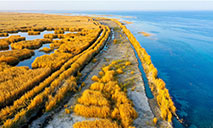China at forefront of global drive for greener Earth

Aerial photo taken on Sept. 23, 2021 shows the autumn scenery of Saihanba forest farm in north China's Hebei Province. (Xinhua/Jin Haoyuan)
BEIJING, Oct. 29 (Xinhua) -- With the highest growth in forest coverage and the largest area of man-made forests, China has taken the lead in the global campaign to green the planet, contributing the biggest share of global vegetation growth between 2000 and 2017.
Attaching great importance to the climate change response, the country is taking systematic and innovative measures to promote the coordinated conservation of various land systems and raise the level of afforestation.
IMPROVING CARBON SINK CAPACITY
Firmly resolved to reduce carbon emissions, China has strived to increase its carbon sink capacity by conserving existing green ecosystems, adding new forests, grasslands and wetlands, as well as fighting desertification.
The country's forest coverage and forest reserves have both maintained growth for the last 30 years, and China has realized the largest growth in forest resources among all countries, according to China's white paper on biodiversity conservation.
From 2016 to 2020, around 36.3 million hectares of forests were planted, and about 42.5 million hectares of forests were tended. The country restored 467,400 hectares of degraded wetlands, and added 202,600 hectares of new wetlands, according to China's white paper on responding to climate change.
At the end of 2020, China's forest area stood at 220 million hectares, with a forest coverage rate of 23 percent, and a forest carbon storage of 9.19 billion tonnes.
In the decade from 2010 and 2020, 7.2 million hectares of marginal farmlands were turned into forests and grasslands, the white paper said.
By 2020, the vegetation coverage of China's grasslands was 56.1 percent, and more than half of the country's wetland areas were under protection.
In the 2016-2020 period, China also implemented desertification control for almost 11 million hectares of land, addressed stony desertification on 1.65 million hectares, and comprehensively treated soil erosion on an additional 310,000 square kilometers of land.
China has adopted a series of effective policies to improve its ability to adapt to climate change in recent years, such as optimizing its industrial and energy structures, improving its energy efficiency and increasing its forest carbon sink capacity, according to Ye Min, China's vice minister of ecology and environment.
The country's carbon intensity in 2020 was 48.4 percent less than that in 2005, which means China more than fulfilled its commitment of achieving a 40-45 percent reduction in carbon intensity from the 2005 level by 2020, Ye noted.
CONSISTENT, INNOVATIVE APPROACHES
The secret behind the rapid growth of China's green land lies in its systematic approach to land greening, which focuses on creating a spatial configuration for green development and implementing key projects for green land conservation across the country.
It has drawn redlines for identified protected areas (PAs), areas that are ecologically vital and vulnerable but not included in PAs, and areas with important potential ecological value, to facilitate the recovery of the ecosystems and increase their carbon sequestration capacity.
China was the first globally to propose and implement the red line strategy for ecological conservation, an important institutional innovation in its land-use planning and eco-environmental reform.
By the end of 2020, the country had established 474 national nature reserves, which accounted for more than a tenth of its landmass.
Since the first nature reserve was set up in 1956, China has established close to 10,000 PAs of all types and at all levels, accounting for about 18 percent of its total land area.
In recent years, the country has built a PA system with national parks as the mainstay, supported by nature reserves and supplemented by nature parks.
China has established its first five national parks as part of its efforts to integrate and optimize nature reserves.
The country's "Drawing a 'Red Line' for Ecological Protection to Mitigate and Adapt to Climate Change" proposal has been selected by the United Nations as one of the 15 best Nature-based Solutions around the globe.
The coordinated conservation of mountains, rivers, forests, farmlands, lakes, grasslands and deserts has also been an important part of China's campaign for green land protection.
Key projects have been promoted in the country's move toward large-scale land afforestation, including the Three-North Shelterbelt Forest Program, the protection of forests along the Yangtze River and black earth in the northeastern regions, as well as the control of the sources of dust storms affecting the cities of Beijing and Tianjin.
China has implemented major ecological conservation and restoration projects in seven key areas, and supported 25 trials to conserve and restore mountain, river, forest, farmland, lake, and grassland ecosystems.
The country has also enacted the Master Plan on Major Projects for the Conservation and Restoration of National Key Ecosystems (2021-2035), specifying an overall conservation configuration for the new era composed of the Three Eco-zones and Four Shelterbelts -- the Qinghai-Tibet Plateau Eco-zone, the Yellow River Eco-zone, the Yangtze River Eco-zone, the Northeast Shelterbelt, the North Shelterbelt, the South Shelterbelt, and the Coastal Shelterbelt.
Photos
Related Stories
Copyright © 2021 People's Daily Online. All Rights Reserved.










